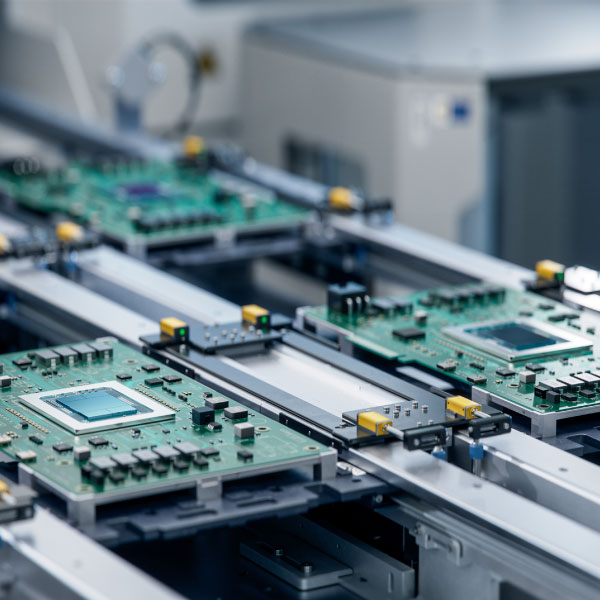The electronics industry is at the forefront of technological innovation, with rapid advancements in consumer electronics, semiconductors, and communication devices. As the demand for faster, more reliable, and cost-effective production processes grows, automation and robotics have become indispensable tools in driving efficiency, improving quality, and maintaining competitiveness. This article explores the latest automation and robotics solutions that are transforming the electronics manufacturing landscape.



The Role of Automation in Electronics Manufacturing
Automation in electronics manufacturing is characterized by the use of advanced machinery and software systems to streamline production processes. These technologies reduce the need for manual intervention, minimize human error, and enable higher precision in soldering, assembly, testing, and inspection tasks.
1. Surface Mount Technology (SMT) and Automated Optical Inspection (AOI):
SMT is a pivotal technology in electronics manufacturing, enabling the placement of components onto printed circuit boards (PCBs) with high precision. Automated optical inspection (AOI) systems are integrated into SMT lines to inspect solder joints and component placements in real time, ensuring that defects are detected and corrected immediately. These systems use high-resolution cameras and advanced algorithms to identify issues, thereby enhancing the reliability and quality of the final product.
2. Robotic Assembly:
Robots are increasingly being used in the assembly of electronic components, where precision and consistency are critical. Robotic arms equipped with vision systems can handle delicate components, perform complex assembly tasks, and operate at speeds that far exceed human capabilities. This is particularly important in the production of small and complex devices such as smartphones and wearables, where even minor errors can lead to significant product failures.
3. Automated Testing and Quality Control:
Testing and quality control are essential in ensuring that electronic products meet the required standards. Automation in testing involves the use of robotic systems to perform repetitive tests, such as functional testing of PCBs, endurance testing of components, and thermal testing under varying conditions. Automated systems can perform these tests with high accuracy, reducing the time required for testing and ensuring that products meet stringent quality standards before they reach the market.
Robotics in the Electronics Industry
Robotics is revolutionizing the electronics industry by providing solutions that enhance production efficiency, flexibility, and scalability. The integration of robotics with artificial intelligence (AI) and machine learning (ML) is enabling manufacturers to achieve new levels of automation.
1. Collaborative Robots (Cobots):
Collaborative robots, or cobots, are designed to work alongside human operators, enhancing productivity without compromising safety. In the electronics industry, cobots are used for tasks such as component handling, assembly, and packaging. They can be easily programmed to perform multiple tasks, making them ideal for small-batch production and flexible manufacturing environments. Cobots also offer a cost-effective solution for automating processes in smaller facilities where traditional industrial robots may not be feasible.
2. Autonomous Mobile Robots (AMRs):
AMRs are gaining traction in electronics manufacturing for their ability to transport materials, components, and finished products within a facility autonomously. These robots use sensors and advanced navigation systems to move around the factory floor, avoiding obstacles and optimizing delivery routes. AMRs can significantly reduce the time and labor costs associated with material handling, allowing human workers to focus on more complex tasks.
3. AI-Powered Robotics:
AI-powered robotics is one of the most promising areas of innovation in the electronics industry. By integrating AI and machine learning algorithms, robots can learn from data, improve their performance over time, and adapt to changing production requirements. For example, AI-driven robots can optimize the placement of components on PCBs, adjust assembly processes based on real-time feedback, and even predict maintenance needs to minimize downtime.
The Benefits of Automation and Robotics in Electronics Manufacturing
The adoption of automation and robotics in the electronics industry offers numerous benefits, including:
– Increased Efficiency: Automated systems and robots can operate 24/7, significantly increasing production throughput and reducing lead times.
– Enhanced Quality: Automation ensures consistent production quality by minimizing human error and enabling real-time monitoring and correction of defects.
– Cost Savings: While the initial investment in automation and robotics can be substantial, the long-term savings in labor costs, material waste, and production efficiency make it a worthwhile investment.
– Flexibility: Modern robotics solutions are highly adaptable, allowing manufacturers to quickly reconfigure production lines to accommodate new products or changes in demand.
– Scalability: Automation and robotics enable manufacturers to scale production up or down with minimal disruption, making it easier to meet market demands.
Real-World Examples of Automation and Robotics in the Electronics Industry
Several leading companies in the electronics industry have successfully integrated automation and robotics into their production processes, setting benchmarks for innovation and efficiency. For instance, Foxconn, a major manufacturer of electronics for brands like Apple and Sony, has implemented over 100,000 robots in its assembly lines, significantly reducing labor costs and increasing production speed. These robots, known as “Foxbots,” perform tasks such as assembling small components and soldering, which require high precision and consistency.
Another example is Samsung, which has invested heavily in robotic automation for its semiconductor manufacturing plants. Samsung uses advanced robotics for wafer handling, inspection, and packaging, ensuring the highest standards of quality and efficiency in its production lines. These robots operate in cleanroom environments, where human intervention is minimized to prevent contamination and defects.
Additionally, Tesla has automated a significant portion of its electronics manufacturing processes in its Gigafactories. The company uses robotic arms to assemble battery modules and power electronics, allowing for faster production cycles and improved product quality. Tesla’s integration of AI-powered robotics also enables predictive maintenance, reducing downtime and ensuring that its production lines run smoothly.
These real-world examples demonstrate how automation and robotics are not just theoretical concepts but are actively shaping the future of electronics manufacturing, leading to more efficient, scalable, and high-quality production systems. Conclusion
As the electronics industry continues to evolve, the role of automation and robotics will only grow in importance. By embracing these technologies, manufacturers can stay competitive in a fast-paced market, deliver high-quality products, and meet the ever-increasing demands of consumers. The future of electronics manufacturing lies in the seamless integration of automation and robotics, paving the way for smarter, more efficient, and more resilient production processes.




